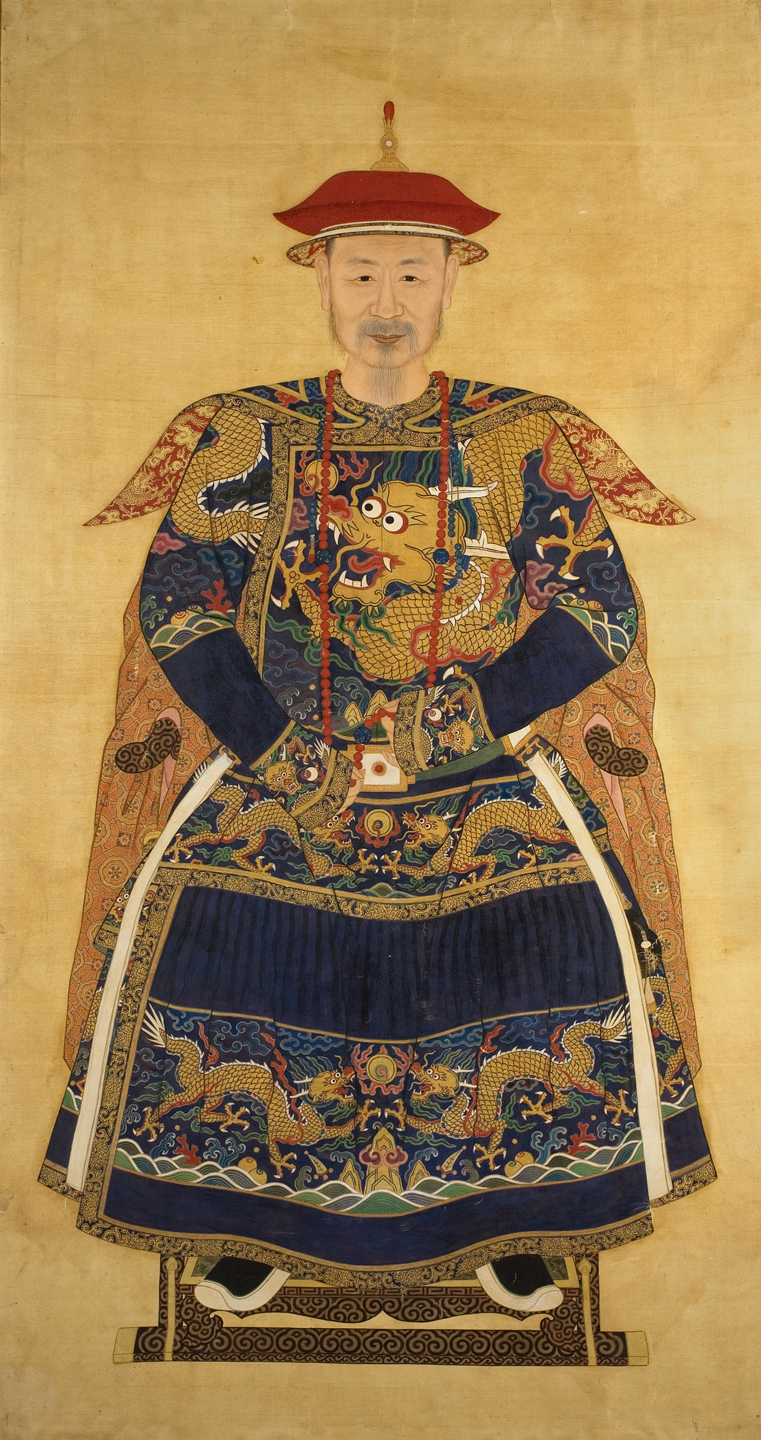Students will explore the significance of the illustrations on the Maya Vase with Palace Scene, then write a short creative or personal story in which the theme of gift giving plays a prominent role.
Students will be able to:
- describe the artistic characteristics of the Maya Vase with Palace Scene;
- explain how the definition of what would be considered a “valuable” gift has changed over the course of time; and
- write a creative short story in which gift giving plays a prominent role.
Lesson
- Display the Maya Vase with Palace Scene and invite the students to examine it closely. What do they notice? What is happening in the illustrations? What do the students think the hieroglyphs might say? What might have been the purpose and function of the vessel? Does this vessel remind the students of any other art objects they have seen? If so, which ones and why?
- Discuss with the students how the illustrations on this vessel depict a marriage negotiation. Share that the potential bridegroom has brought two circular woven fans, several stacks of textiles, three large bags of cacao beans, and a cone of salt or rubber as gifts for the potential bride’s family. Explain that one of the gifts, cacao, held a particular place of importance in Maya civilization, functioning as both currency and the basis for a chocolate drink. Refer to the About the Art sheet for more information.
- Ask the students: What kinds of items have been viewed as valuable gifts during previous historical periods? What types of items would be considered important gifts in contemporary society? Write the students’ responses on a whiteboard or large sheet of easel paper.
- Provide a brief summary of and read an excerpt from O. Henry’s The Gift of the Magi. Ask the students: Do you think the gifts that the two main characters in the story gave to each other were valuable? Why or why not?
- Encourage the students to think of a time when they gave or received a valuable gift. Have the students share their experiences with a classmate, then ask if any volunteers want to share their stories with the rest of the class.
- Invite the students to elaborate on the theme of gift giving using their writing abilities! Ask the students to write a creative short story in which gift giving plays a prominent role (refer to The Gift of the Magi again for inspiration) or to write about a time when they gave or received an important gift (perhaps based on the experience they shared earlier).
- If time allows, have the students share their creative or autobiographical stories with each other in small groups!
Materials
- Copy of O. Henry’s short story The Gift of the Magi, available through the Internet or a library
- Lined paper and pen/pencil for each student
- About the Art sheet on Maya Vase with Palace Scene (found at the end of the lesson plan) or student access to this part of Creativity Resource online
- One color copy of the vase for every four students, or the ability to project the image onto a wall or screen
Standards
- Language Arts
- Collaboration
- Critical Thinking & Reasoning
- Information Literacy
- Invention
- Self-Direction
Cylinder Vessel with Image of Seated Lord and Attendants at Court
We don’t know the name of the artist who made this vessel, but it’s apparent that they were very skilled. The artist was able to give the human figures depicted on the vessel depth and substance, conveying individual personalities and even humor. A hieroglyphic text encircles the top of the vessel and occurs within the painted scene. It took great skill to paint both the figures and hieroglyphs with such control.
The glyphic text indicates that this vessel was probably made in what is now Guatemala. Vessels like this were made from local clays and other materials that were added for strength. Before firing the vessel, the artist covered it with a white or orange slip, a mixture of clay and water, to serve as background color. The artist then painted images and designs onto the polished surface with mineral-pigmented slips. The last step was to fire the vessel in an open pit.
The inscription on this vessel tells us it was crafted for the father of the central, seated lord and was used for drinking cacao or chocolate. Painted on the thin-walled cylindrical vessel is a scene of palace life that involves a tribute payment to the lord. Goods on display include two circular fans woven of reed or palm leaf, several stacks of textiles, and three large bags of cacao or chocolate beans. Cacao beans were a gourmet food item and could also be used as a form of money. While the assembled men participate openly in the event, two women (seated on the right) are shielded from public view. Probably members of the noble household, they appear to listen to the discussion with interest.
Life in noble Maya courts was both luxurious and sophisticated. Maya cities incorporated elaborate stone and stucco architecture, carved ruler portraits on free-standing stone slabs, and painted large-scale mural scenes. Elegant, multi-colored painted ceramics were owned and used by the elite.
Details
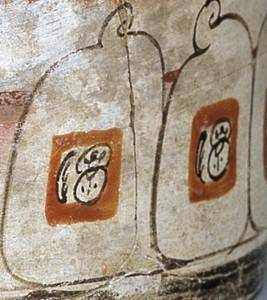
Bags of Cacao Beans
The Maya used cacao as the basis for chocolate drinks and as a form of currency. Three bags of cacao beans are depicted on the step below the principle lord and the youths, probably sons, who sit next to him.
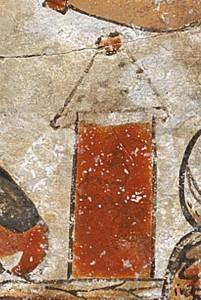
Cacao Vessel
Directly in front of the principle lord is a tall cylindrical vessel, most likely filled with a chocolate beverage.
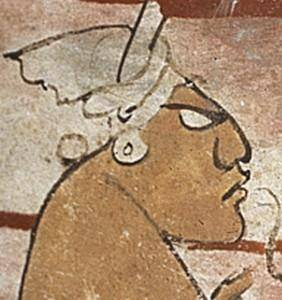
Sloping Forehead
A sloping forehead and elongated head shape were signs of beauty among the Maya elite. Sometimes, an infant’s still soft head was bound between boards to achieve the desired head shape, emphasizing a smooth unbroken line between the nose and the forehead.
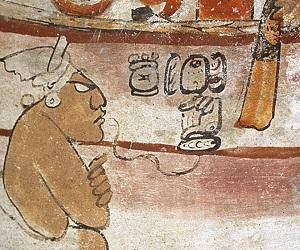
Pink Wash
A delicate pink wash shades the inscriptions and the scene. The colored wash provides the vessel with a distinct look.

Setting
The artist has arranged the ten figures in an interior space that features a two-level platform, curtains, and woven mats.
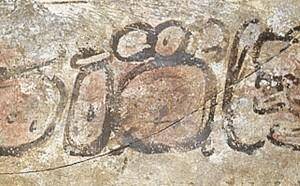
Hieroglyphs
The painted inscription records the name of the large central figure, who is the ruler of the court (Nabnal K’inich Lakam). It also names his father (Yuknoom K’awiil), from the site of Rio Azul in present-day Guatemala. The inscription also identifies the vessel as a drinking vessel for cacao or chocolate.
Funding for object education resources provided by a grant from the Morgridge Family Foundation. Additional funding provided by the William Randolph Hearst Endowment for Education Programs, and Xcel Energy Foundation. We thank our colleagues at the University of Denver Morgridge College of Education.
The images on this page are intended for classroom use only and may not be reproduced for other reasons without the permission of the Denver Art Museum. This object may not currently be on display at the museum.





